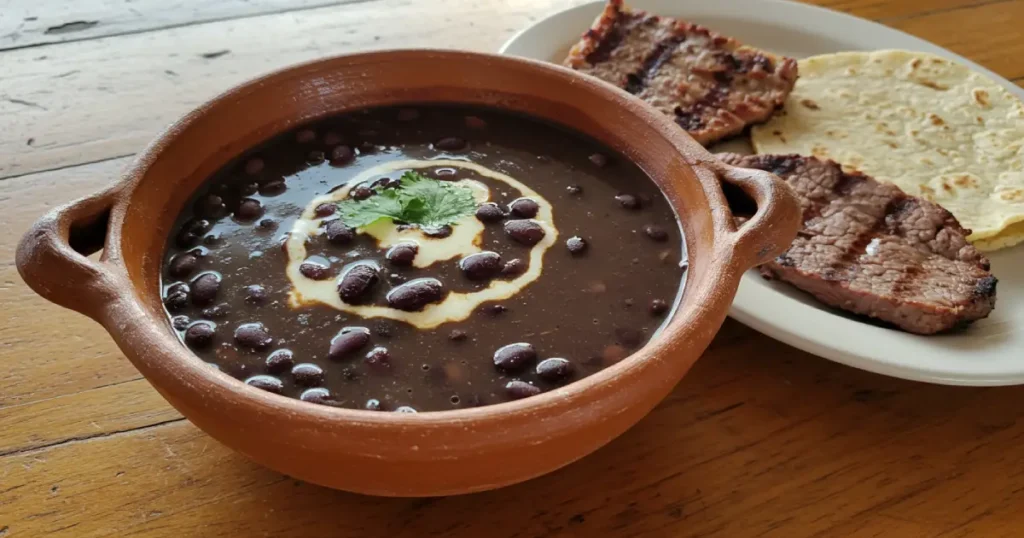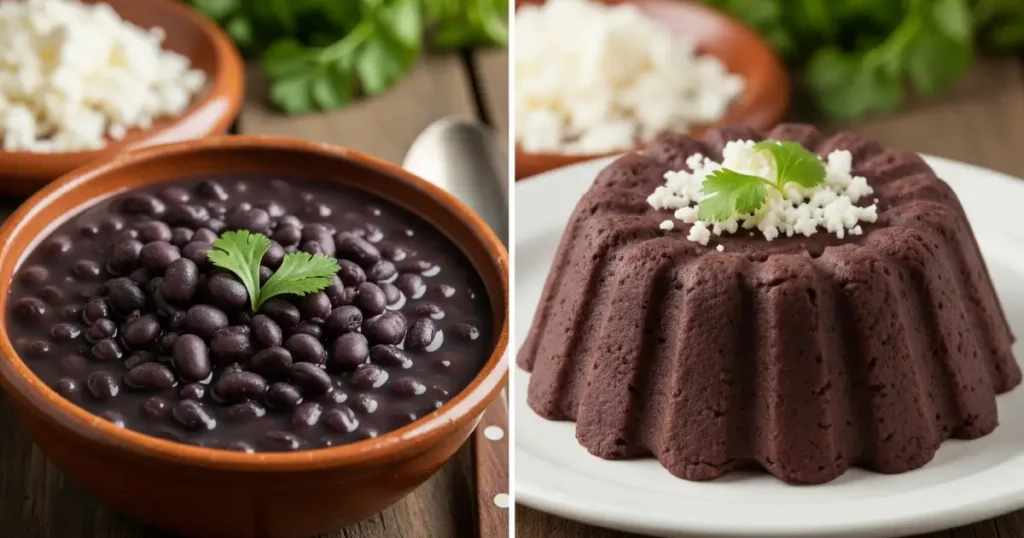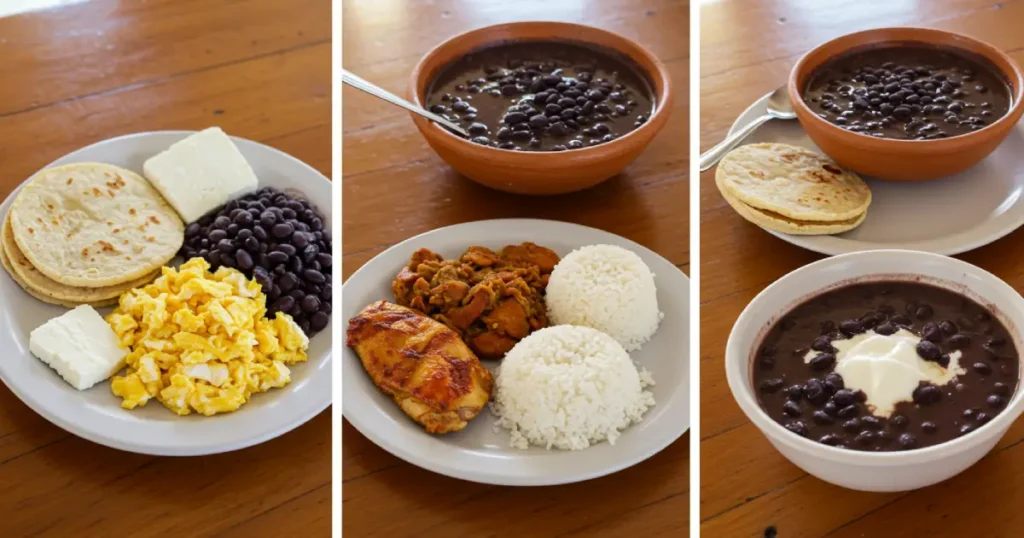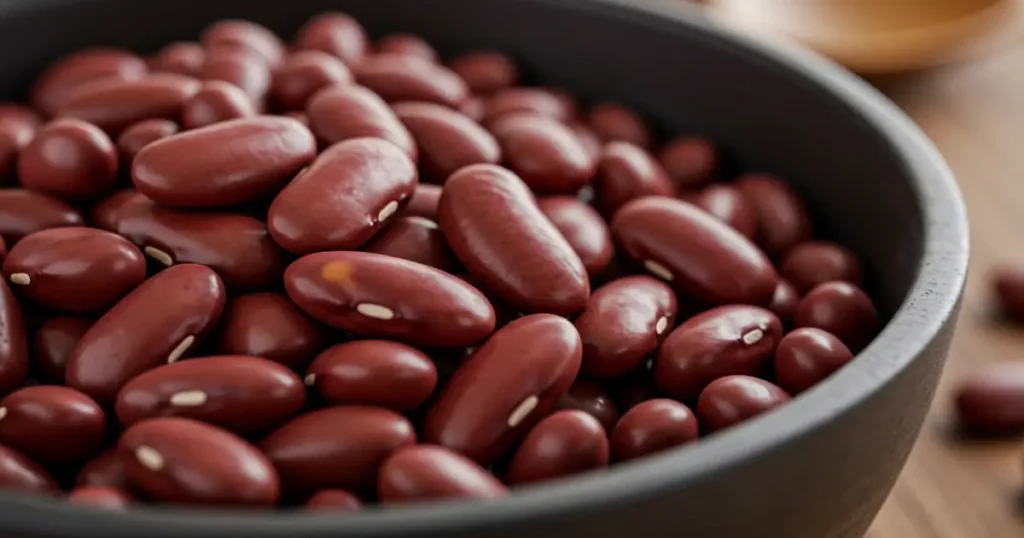Frijoles Parados: Authentic Guatemalan Whole Black Beans Recipe & Cultural Guide

In the rich culinary landscape of Guatemala, where ancient Mayan heritage blends seamlessly with Spanish colonial influences, beans are more than just a food item; they are a foundational pillar of daily life and cultural identity. While many are familiar with the smooth, rich delight of frijoles volteados (refried beans), there exists an equally beloved, simpler, yet profoundly satisfying preparation: frijoles parados.

These standing beans, typically whole black beans simmered to tender perfection in their own flavorful broth, represent a taste of home, tradition, and everyday sustenance for countless Guatemalans.
This article invites you to explore the world of frijoles parados, to understand their unique characteristics, their deep historical roots, how they are meticulously prepared in Guatemalan kitchens, and the many ways they are savored. Join us as we delve into this soulful dish that captures the essence of Guatemalan home cooking.
Understanding Frijoles Parados: More Than Just "Standing Beans"
The term frijoles parados literally translates to standing beans. This name aptly describes their presentation: whole beans served in their cooking liquid, as opposed to being mashed or refried. They are often referred to more generally as frijoles de la olla (beans from the pot), highlighting their straightforward, pot-cooked nature.
The Meaning of Parados
Parados emphasizes that the beans remain intact, standing in their broth rather than being transformed in texture. This simple distinction is key to their identity and culinary role. While frijoles volteados are prized for their dense, spreadable consistency, frijoles parados celebrate the integrity of the whole bean, its natural texture, and the savory broth created during the cooking process.
Key Characteristics: Texture, Appearance, Flavor
- Texture: Frijoles parados are tender and creamy, having been slow-simmered until perfectly soft, yet still holding their individual shape. They are served with a variable amount of their cooking liquid, ranging from a slightly brothy consistency to a thicker, more concentrated "caldito" (little broth).
- Appearance: Typically, these are black beans (Phaseolusvulgaris), which impart a deep, dark, almost inky color to both the beans and their surrounding liquid. The broth itself can range from a dark brown to an opaque black, rich with the essence of the beans.
- Flavor: The flavor profile is earthy, savory, and deeply bean-forward. The primary taste comes from the beans themselves, enhanced by simple aromatics like onion and garlic, and seasoned with salt. Some cooks might add a sprig of epazote for a distinct herbal note, though this is less universally standard for basic frijoles parados compared to some other bean dishes in Mesoamerica. The slow simmering process allows the beans to absorb the flavors of the aromatics and develop a rich, satisfying taste.
Frijoles Parados vs. Frijoles Volteados: A Tale of Two Beans

Understanding the distinction between frijoles parados and frijoles volteados is crucial to appreciating Guatemalan bean cookery:
- Frijoles Parados (Whole Beans):
- Cooked whole and served in their broth.
- Simpler preparation, focusing on the natural flavor and texture of the beans.
- Often the first stage of bean preparation; leftover frijoles parados can be used to make frijoles volteados.
- Served as a soupy side, a component in dishes like rice and beans, or as a simple meal with tortillas.
- Frijoles Volteados (Refried Beans):
- Cooked beans are mashed or blended and then fried (refried) with fat and additional seasonings until thick and paste-like.
- Richer, more intense flavor due to the refrying process and added fat.
- Denser, smoother, and often spreadable texture.
- Typically served as a side, a filling, or a dip.
While distinct, these two preparations are intimately linked. It's very common to cook a large pot of frijoles parados, enjoy them for a meal or two, and then transform the leftovers into frijoles volteados, showcasing the resourcefulness inherent in traditional Guatemalan cooking.
The Enduring Legacy: History and Cultural Importance
The story of frijoles parados is deeply intertwined with the history of Mesoamerica and the daily lives of Guatemalans.
Ancient Roots in Mesoamerican Diet
Beans have been a cornerstone of the Mesoamerican diet for thousands of years, cultivated alongside maize and squash in the ancient agricultural system known as the "three sisters." The Maya civilization, which thrived in Guatemala, relied heavily on beans as a primary source of protein. The simple act of simmering beans in a pot with water and perhaps some local herbs is a tradition that stretches back centuries, long before European contact. These early forms of "frijoles de la olla" were the direct ancestors of today's frijoles parados.
A Daily Sustenance in Guatemalan Households
Frijoles, in all their forms, are a fundamental part of the Guatemalan diet, consumed by people of all social strata. As noted in studies, for many Guatemalans, particularly those in lower socio-economic groups, beans and maize form the bulk of their daily caloric and protein intake. Frijoles parados, being the most basic and often most economical way to prepare beans, are a daily reality in countless homes. They provide essential nutrients, comfort, and a sense of culinary tradition. A pot of beans simmering on the stove is a familiar and welcoming aroma in Guatemalan households.
Role in Traditional Meals and Gatherings

Frijoles parados are a versatile component of many traditional Guatemalan meals. They are commonly served for breakfast, lunch, and dinner.
- Breakfast: Often accompanying eggs, tortillas, and perhaps a piece of cheese.
- Lunch/Dinner: Served alongside rice, grilled meats, chicken, or as part of a simple, nourishing meal with tortillas for dipping into the flavorful broth. They can also be the base for more elaborate soups or stews.
While perhaps less "festive" than some other national dishes, their constant presence makes them an integral part of everyday family meals and informal gatherings. Their simplicity allows the quality of the beans and the care in their preparation to shine through.
Crafting Authentic Frijoles Parados: A Guatemalan Recipe

Making a pot of frijoles parados is a straightforward process, though it requires patience to achieve the perfect tenderness and flavor.
Essential Ingredients for Frijoles Parados
The beauty of frijoles parados lies in their simplicity. The core ingredients are few:
- Black Beans: Dried black beans are the preferred choice in Guatemala. Look for beans that are relatively uniform in size and color.
- Water: Good quality water is essential, as it forms the base of the flavorful broth.
- Aromatics:
- Onion: Usually a piece of white onion is added to the pot during cooking for flavor.
- Garlic: A few cloves of garlic, often left whole or lightly smashed, contribute a foundational savory note.
- Salt: Added towards the end of the cooking process, as adding it too early can sometimes toughen the bean skins.
- Optional Flavor Enhancers:
- Epazote: This pungent herb is sometimes used in bean dishes in Mesoamerica for its distinctive flavor and purported digestive benefits. Its use in basic Guatemalan frijoles parados varies.
- Lard or Oil: While frijoles parados are not fried, a very small amount of lard or oil might be added by some cooks at the beginning for a subtle richness, though many traditional recipes rely solely on water.
Step-by-Step Cooking Instructions
- Sorting and Rinsing: Spread the dried black beans on a clean surface and pick through them carefully, removing any small stones, debris, or discolored/broken beans. Rinse the beans thoroughly under cold running water.
- Soaking the Beans (Highly Recommended):
- Place the rinsed beans in a large pot or bowl.
- Cover with ample cold water (at least 2-3 inches above the beans).
- Let the beans soak for at least 8 hours, or overnight. Soaking rehydrates the beans, reduces cooking time significantly, and can help make them more digestible.
- After soaking, drain the soaking water and rinse the beans again. Note: Some traditionalists prefer to cook black beans in their soaking water to retain the deep black color. This is a matter of preference.
- The Slow Simmer: Achieving Tenderness and Flavor:
- Place the soaked and rinsed beans into a large, heavy-bottomed pot (an earthenware "olla" is traditional, but any sturdy pot will do).
- Add fresh water to cover the beans by about 2-3 inches.
- Add the piece of onion and the garlic cloves to the pot. Do not add salt at this stage.
- Bring the water to a rolling boil over high heat.
- Once boiling, reduce the heat to low, cover the pot with a lid (leaving it slightly ajar to prevent boiling over), and let the beans simmer gently.
- Cook for 1.5 to 3 hours, or even longer, depending on the age and type of beans, and whether they were soaked. The goal is for the beans to become completely tender, easily mashed between your fingers or with a fork.
- Check the water level periodically during cooking, adding more hot water if needed to keep the beans submerged. Avoid adding cold water, as this can shock the beans and affect their texture.
- Stir the beans occasionally to prevent them from sticking to the bottom of the pot.
- Seasoning to Perfection:
- Once the beans are very tender, stir in salt to taste. Start with about 1 teaspoon and add more as needed. Some cooks also like to add a pinch of black pepper.
- If using epazote, you can add a sprig during the last 20-30 minutes of cooking.
- Continue to simmer for another 20-30 minutes after adding the salt to allow the beans to absorb the seasoning.
- Remove and discard the large pieces of onion and garlic cloves (or leave them in, if preferred) before serving. The beans should be soft, and the broth should be flavorful and slightly thickened from the starches released by the beans.
Tips for Perfect Frijoles Parados Every Time
- Use Quality Beans: Fresher dried beans cook more evenly and have better flavor.
- Don't Underestimate Soaking: It truly makes a difference in texture and cooking time.
- Gentle Simmer: Avoid a rapid boil once the initial boil is reached. A gentle simmer allows the beans to cook evenly without breaking apart too much.
- Salt Towards the End: As mentioned, adding salt too early can result in tougher beans.
- Patience is Key: Good frijoles parados cannot be rushed. The slow cooking process is what develops their creamy texture and deep flavor.
- Taste and Adjust: Seasoning is personal. Taste the broth towards the end and adjust salt as needed.
Regional Variations and Local Touches
While the basic method for frijoles parados is quite consistent across Guatemala, especially with black beans being the dominant choice, subtle variations can occur:
Subtle Differences Across Guatemalan Regions
- Aromatics: The specific aromatics might vary slightly. For example, some areas might be more inclined to add a specific local herb or a hint of chili.
- Broth Consistency: Some may prefer a thinner, more soupy broth, while others like it more concentrated and slightly thicker. This can often be adjusted by how much water is added or how long the beans are simmered after reaching tenderness.
- Type of Bean: While black beans are king for this style in Guatemala, in some households or regions, red beans (frijoles colorados) might occasionally be prepared "parados," though they are more commonly associated with other dishes or regional preferences within Central America more broadly.
Family Recipes and Generational Traditions
Often, the most significant variations are found within family recipes passed down through generations. A grandmother's specific technique for achieving the perfect tenderness, a particular way of seasoning, or a preferred type of pot can all contribute to unique family versions of this beloved dish. These subtle touches are what make home-cooked frijoles parados so special.
How to Serve and Enjoy Frijoles Parados
Frijoles parados are incredibly versatile and can be enjoyed in numerous ways, forming the backbone of many Guatemalan meals.
As a Standalone Dish (e.g., Frijoles de la Olla)
One of the simplest and most satisfying ways to enjoy frijoles parados is as "frijoles de la olla" – a comforting bowl of whole beans in their savory broth. This can be a light meal in itself, often accompanied by:
- Warm corn tortillas for dipping.
- A sprinkle of queso fresco or queso seco (crumbly fresh or dry cheese).
- A dollop of crema (Guatemalan sour cream).
- A side of sliced avocado.
- A spoonful of salsa or a dash of picante (hot sauce).
Accompaniments: Rice, Tortillas, Meats, Eggs
Frijoles parados are a classic accompaniment to a wide array of dishes:
- With Rice: A simple plate of white rice and frijoles parados (sometimes mixed, known as "casamiento" or "gallo pinto" in other Central American contexts, though in Guatemala "casamiento" more often implies refried beans mixed with rice) is a staple.
- With Tortillas: Essential for scooping up the beans and soaking up the broth.
- With Meats: Served alongside grilled chicken (pollo asado), beef (carne asada), or pork.
- With Eggs: A common component of a Guatemalan breakfast, served with scrambled or fried eggs (huevos revueltos o estrellados).
Incorporating Frijoles Parados into Other Dishes
The utility of frijoles parados extends beyond being just a side dish:
- Base for Soups: The beans and their broth can serve as a nutritious base for heartier soups, with vegetables and sometimes meat added.
- Component in Rice and Beans: As mentioned, they can be combined with rice.
- Ingredient for Salads: Chilled whole cooked beans can be added to salads.
Nutritional Profile: The Healthy Goodness of Whole Beans
Frijoles parados, being primarily whole black beans simmered in water with minimal additions, are an exceptionally nutritious food.
Rich in Protein and Fiber
- Plant-Based Protein: Black beans are an excellent source of plant-based protein, crucial for muscle repair, growth, and overall bodily function. This makes them particularly important in vegetarian and vegan diets.
- Dietary Fiber: They are packed with both soluble and insoluble fiber. Fiber aids in digestion, promotes satiety (helping with weight management), helps regulate blood sugar levels, and contributes to lowering LDL (bad) cholesterol.
Vitamins and Minerals
Black beans are a treasure trove of essential micronutrients, including:
- Folate: Important for cell division and DNA synthesis.
- Iron: Crucial for oxygen transport in the blood; consuming beans with a source of Vitamin C (like tomatoes or bell peppers in a salsa) can enhance iron absorption.
- Magnesium: Involved in over 300 biochemical reactions in the body, including muscle and nerve function.
- Potassium: Helps regulate blood pressure and fluid balance.
- Manganese, Phosphorus, Zinc: All play vital roles in various physiological processes.
Contribution to a Balanced Guatemalan Diet
The combination of maize (in tortillas) and beans (like frijoles parados) forms a complete protein, meaning it provides all the essential amino acids the body needs. This synergistic relationship has been the nutritional backbone of Mesoamerican diets for centuries. Frijoles parados are low in fat (especially if no extra fat is added during cooking), naturally cholesterol-free, and have a low glycemic index, making them a healthy choice for sustained energy.
Frijoles Parados: A Taste of Guatemalan Home and Tradition
More than just a simple dish, frijoles parados represent a direct connection to Guatemalan heritage and the comfort of home-cooked food. Their unadorned nature speaks to a culinary tradition that values the inherent goodness of simple, well-prepared ingredients. The aroma of beans simmering on the stove, the sight of a steaming bowl of frijoles parados with their dark, rich broth – these are sensory experiences deeply embedded in the Guatemalan cultural psyche.
They are a testament to the resourcefulness and wisdom of generations who understood how to transform a humble legume into a nourishing, flavorful, and deeply satisfying meal. Frijoles parados are the quiet, unassuming counterpart to the more elaborate dishes, yet they are arguably one of the most authentic and foundational expressions of Guatemalan gastronomy.
Conclusion
Frijoles parados, in their humble simplicity, are a cornerstone of Guatemalan cuisine and culture. These whole, simmered black beans, served in their own flavorful broth, offer a taste of tradition, everyday sustenance, and the comforting embrace of home. Their preparation, though straightforward, is a testament to the art of slow cooking and extracting maximum flavor from basic ingredients.
Whether enjoyed as a simple bowl of frijoles de la olla, as a hearty accompaniment to a larger meal, or as the base for other culinary creations, frijoles parados are a delicious, nutritious, and versatile staple that truly captures the soul of Guatemalan food. Understanding and appreciating this dish is key to understanding the heart of Guatemala's rich culinary heritage.

Leave a Reply